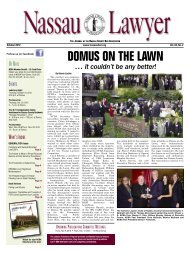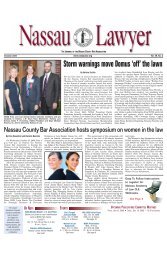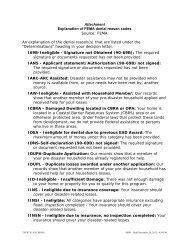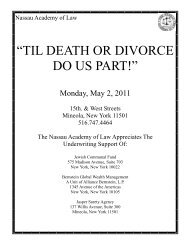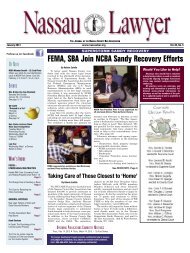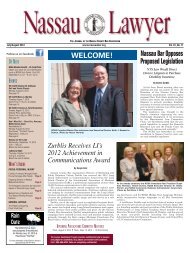780 N.Y.S.2d 409 Page 29 A.D.3d 553, 780 N.Y.S.2d 409, 2004 N.Y. Slip Op. 05710(Cite as: 9 A.D.3d 553, 780 N.Y.S.2d 409)judgment in transferee's action seeking determinationthat funds it received from judgment debtor were notsubject to restraint by judgment creditors.**410 Tabner, Ryan & Keniry, Albany (Eric N.Dratler <strong>of</strong> counsel), for Mega Personal Lines, Inc.,appellant.McNamee, Lochner, Titus & Williams P.C., Albany(Scott C. Paton <strong>of</strong> counsel), for Mega Group, Inc.,appellant.Ianniello, Anderson & Reilly P.C., Clifton Park(Matthew I. Mazur <strong>of</strong> counsel), for Dianne Halton,respondent.Before: SPAIN, J.P., CARPINELLO, MUGGLIN,ROSE and LAHTINEN, JJ.*554 ROSE, J.Appeal from an order and judgment <strong>of</strong> the SupremeCourt (Nolan Jr., J.), entered June 26, 2003 in SaratogaCounty, which, in a proceeding pursuant toCPLR 5239, inter alia, granted a motion by respondentDianne Halton and Robert L. Halton for partialsummary judgment.Petitioner Mega Group, Inc. commenced an actionagainst Robert L. Halton [FN1] and respondent DianneHalton (hereinafter collectively referred to asrespondents) and respondents then interposed a counterclaimfor money damages. During the pendency <strong>of</strong>their counterclaim, Mega Group transferred substantiallyall <strong>of</strong> its assets to petitioner Mega PersonalLines, Inc. (hereinafter MPL). Respondents later obtaineda judgment against Mega Group and sought toenforce it by restraining certain funds held by thirdparties. MPL then commenced this proceeding seekinga determination that the restrained funds are, infact, the property <strong>of</strong> MPL and not Mega Group. Respondentsmoved to dismiss the petition on theground, among others, that the transfer <strong>of</strong> substantiallyall <strong>of</strong> Mega Group's assets to MPL, after respondentshad interposed their counterclaim againstMega Group, was fraudulent within the meaning <strong>of</strong>Debtor and Creditor <strong>Law</strong> § 273-a. Treating themotion as one for summary judgment and findingthat questions <strong>of</strong> fact existed as to whether there wasequivalent value given for the transfer <strong>of</strong> MegaGroup's assets, Supreme Court denied the motion andwe affirmed (297 A.D.2d 428, 746 N.Y.S.2d 204[2002] ).FN1. Robert L. Halton, a named respondentin this proceeding, died while this appealwas pending and his wife, respondent DianneHalton, has been substituted for him.Following discovery, respondents moved for partialsummary judgment, this time arguing Mega Group'slack <strong>of</strong> good faith. Finding the good faith component<strong>of</strong> fair consideration as defined by Debtor and Creditor<strong>Law</strong> § 272 to be lacking as a matter <strong>of</strong> law--regardless <strong>of</strong> whether Mega Group received equivalentvalue for its assets--because Steven Gregory,Mega Group's president and majority shareholder,also held an ownership interest in MPL at the time <strong>of</strong>the transfer, Supreme Court granted respondents'motion. Petitioners now appeal.[1] Initially, we reject petitioners' procedural contentionthat Supreme Court erred by entertaining a secondsummary judgment *555 motion. Because respondents'second motion was made after the completion<strong>of</strong> discovery and, significantly, it turns upon anissue not previously decided, Supreme Court actedwell within its broad discretion (see Baker v. VanderbiltCo., 260 A.D.2d 750, 751-752, 688 N.Y.S.2d 726[1999]; Robbins v. K-Mart Corp., 248 A.D.2d 867,868, 669 N.Y.S.2d 774 [1998] ).[2][3][4] We reach a different conclusion, however,as to Supreme Court's determination that summaryjudgment should be granted here. In order to prevailunder Debtor and Creditor <strong>Law</strong> § 273-a, respondentswere required to prove that the **411 transferorwas a defendant in an action for money damages atthe time <strong>of</strong> the transfer, the transferor has not satisfiedthe resulting judgment and the transfer was madewithout fair consideration (see Berner Trucking v.Brown, 281 A.D.2d 924, 925, 722 N.Y.S.2d 656[2001] ). There is no real dispute here as to the firsttwo elements. The third element, fair consideration,exists when, in exchange for property or an obligation,"as a fair equivalent therefor, and in good faith,property is conveyed or an antecedent debt is satisfied"(Debtor and Creditor <strong>Law</strong> § 272[a] [emphasisadded] ). The good faith <strong>of</strong> both the transferor andtransferee is an indispensable component <strong>of</strong> fair consideration(see Matter <strong>of</strong> Superior Leather Co. v.Lipman Split Co., 116 A.D.2d 796, 797, 496N.Y.S.2d 845 [1986]; Studley, Inc. v. Lefrak, 66© 2009 Thomson Reuters. No Claim to Orig. US Gov. Works.
780 N.Y.S.2d 409 Page 39 A.D.3d 553, 780 N.Y.S.2d 409, 2004 N.Y. Slip Op. 05710(Cite as: 9 A.D.3d 553, 780 N.Y.S.2d 409)A.D.2d 208, 213, 412 N.Y.S.2d 901 [1979], affd. 48N.Y.2d 954, 425 N.Y.S.2d 65, 401 N.E.2d 187[1979] ). Supreme Court resolved this disputed componentby first finding that Gregory was a MegaGroup insider with an ownership interest in MPL atthe time <strong>of</strong> the transfer, and then inferring a lack <strong>of</strong>good faith as a matter <strong>of</strong> law. While we agree withSupreme Court's premise that the transfer <strong>of</strong> corporateassets to an insider establishes a lack <strong>of</strong> goodfaith as a matter <strong>of</strong> law, we note that the principlerequires the transfer <strong>of</strong> assets either directly to theinsider or to an entity controlled by the insider (seeMatter <strong>of</strong> P.A. Bldg. Co. v. Silverman, 298 A.D.2d327, 328, 750 N.Y.S.2d 13 [2002]; Berner Truckingv. Brown, supra; Manufacturers & Traders Trust Co.v. Lauer's Furniture Acquisition, 226 A.D.2d 1056,1057, 641 N.Y.S.2d 947 [1996], lv. dismissed 88N.Y.2d 962, 647 N.Y.S.2d 715, 670 N.E.2d 1347[1996]; Farm Stores v. School Feeding Corp., 102A.D.2d 249, 254, 477 N.Y.S.2d 374 [1984], affd. inpart 64 N.Y.2d 1065, 489 N.Y.S.2d 877, 479 N.E.2d222 [1985] ). Thus, a corporate insider's participationin both the transferor and the transferee is not sufficientto resolve the issue as a matter <strong>of</strong> law unless theinsider controls the transferee. When the insider is thetransferee or controls the transferee, there can be n<strong>of</strong>actual dispute that the purpose <strong>of</strong> the transfer was toconfer on the insider a preference over other creditors(see Matter <strong>of</strong> Superior Leather Co. v. Lipman SplitCo., supra at 797, 496 N.Y.S.2d 845).there<strong>of</strong> as granted the motion <strong>of</strong> respondent DianneHalton and Robert L. Halton for partial summaryjudgment; motion denied; and, as so modified, affirmed.SPAIN, J.P., CARPINELLO, MUGGLIN andLAHTINEN, JJ., concur.9 A.D.3d 553, 780 N.Y.S.2d 409, 2004 N.Y. SlipOp. 05710END OF DOCUMENT[5] While we agree with Supreme Court that Gregory'saffidavit *556 raises only feigned factual issuesdesigned to avoid the consequences <strong>of</strong> his earlierdeposition testimony admitting his interest in MPL atthe time <strong>of</strong> transfer (see Richter v. Collier, 5 A.D.3d1003, 1004, 773 N.Y.S.2d 645 [2004]; Martin v.Savage, 299 A.D.2d 903, 904, 750 N.Y.S.2d 684[2002] ), there is no evidence that his 40% interestwas a controlling one or that MPL was merely analter ego <strong>of</strong> either Gregory or Mega Group. Also,MPL <strong>of</strong>fered evidence that Gregory did not effectivelycontrol MPL. This question <strong>of</strong> control is sufficientto raise a triable issue <strong>of</strong> fact as to whether therewas a shuffling <strong>of</strong> corporate assets that gave a preferenceto Gregory's interests over respondents' claim(see Rebh v. Rotterdam Ventures, 252 A.D.2d 609,611, 675 N.Y.S.2d 234 [1998] ).ORDERED that the order and judgment is modified,on the law, without costs, by reversing so much© 2009 Thomson Reuters. No Claim to Orig. US Gov. Works.
- Page 1 and 2:
Nassau Academy of LawCLE Live Class
- Page 3 and 4:
McKinney's Debtor and Creditor Law
- Page 5 and 6:
McKinney's Debtor and Creditor Law
- Page 7 and 8:
McKinney's Debtor and Creditor Law
- Page 9 and 10:
McKinney's Debtor and Creditor Law
- Page 11 and 12:
McKinney's Debtor and Creditor Law
- Page 13 and 14:
McKinney's Debtor and Creditor Law
- Page 15 and 16:
McKinney's Debtor and Creditor Law
- Page 17 and 18:
McKinney's Debtor and Creditor Law
- Page 19 and 20:
BAKER & HOSTETLER LLP45 Rockefeller
- Page 21 and 22:
usiness of defendant Bernard L. Mad
- Page 23 and 24:
BACKGROUND, THE TRUSTEE, AND STANDI
- Page 25 and 26:
Madoff who received fraudulent tran
- Page 27 and 28:
ased on fictitious profits and for
- Page 29 and 30:
28. BLMIS funds were also used to p
- Page 31 and 32:
Madoff, and her niece, Shana Madoff
- Page 33 and 34:
42. Ruth Madoff was never an employ
- Page 35 and 36:
FIRST CAUSE OF ACTIONTURNOVER AND A
- Page 37 and 38:
66. At the time of each of the Two-
- Page 39 and 40:
Transfers; (b) directing that the S
- Page 41 and 42:
EIGHTH CAUSE OF ACTIONUNDISCOVERED
- Page 43 and 44:
TENTH CAUSE OF ACTIONDISALLOWANCE O
- Page 45 and 46:
111. Mrs. Madoff benefited from the
- Page 47 and 48:
WHEREFORE, the Trustee respectfully
- Page 49 and 50:
2(c)(3): (a) preserving the Subsequ
- Page 51 and 52:
302 B.R. 760 Page 1302 B.R. 760(Cit
- Page 53 and 54:
302 B.R. 760 Page 3302 B.R. 760(Cit
- Page 55 and 56:
302 B.R. 760 Page 5302 B.R. 760(Cit
- Page 57 and 58:
302 B.R. 760 Page 7302 B.R. 760(Cit
- Page 59 and 60:
302 B.R. 760 Page 9302 B.R. 760(Cit
- Page 61 and 62:
302 B.R. 760 Page 11302 B.R. 760(Ci
- Page 63 and 64:
302 B.R. 760 Page 13302 B.R. 760(Ci
- Page 65 and 66:
302 B.R. 760 Page 15302 B.R. 760(Ci
- Page 67 and 68:
302 B.R. 760 Page 17302 B.R. 760(Ci
- Page 69 and 70:
302 B.R. 760 Page 19302 B.R. 760(Ci
- Page 71 and 72:
394 B.R. 721 Page 1394 B.R. 721, 50
- Page 73 and 74:
394 B.R. 721 Page 3394 B.R. 721, 50
- Page 75 and 76:
394 B.R. 721 Page 5394 B.R. 721, 50
- Page 77 and 78:
394 B.R. 721 Page 7394 B.R. 721, 50
- Page 79 and 80:
394 B.R. 721 Page 9394 B.R. 721, 50
- Page 81 and 82: 394 B.R. 721 Page 11394 B.R. 721, 5
- Page 83 and 84: 394 B.R. 721 Page 13394 B.R. 721, 5
- Page 85 and 86: 394 B.R. 721 Page 15394 B.R. 721, 5
- Page 87 and 88: 394 B.R. 721 Page 17394 B.R. 721, 5
- Page 89 and 90: 394 B.R. 721 Page 19394 B.R. 721, 5
- Page 91 and 92: 394 B.R. 721 Page 21394 B.R. 721, 5
- Page 93 and 94: 397 B.R. 642 Page 2397 B.R. 642(Cit
- Page 95 and 96: 397 B.R. 642 Page 4397 B.R. 642(Cit
- Page 97 and 98: 397 B.R. 642 Page 6397 B.R. 642(Cit
- Page 99 and 100: 397 B.R. 642 Page 8397 B.R. 642(Cit
- Page 101 and 102: 397 B.R. 642 Page 10397 B.R. 642(Ci
- Page 103 and 104: 397 B.R. 642 Page 12397 B.R. 642(Ci
- Page 105 and 106: 397 B.R. 642 Page 14397 B.R. 642(Ci
- Page 107 and 108: 443 F.3d 180 Page 2443 F.3d 180(Cit
- Page 109 and 110: 443 F.3d 180 Page 4443 F.3d 180(Cit
- Page 111 and 112: 443 F.3d 180 Page 6443 F.3d 180(Cit
- Page 113 and 114: 443 F.3d 180 Page 8443 F.3d 180(Cit
- Page 115 and 116: 443 F.3d 180 Page 10443 F.3d 180(Ci
- Page 117 and 118: 443 F.3d 180 Page 12443 F.3d 180(Ci
- Page 119 and 120: Page 2257 A.D.2d 526, 684 N.Y.S.2d
- Page 121 and 122: Page 4257 A.D.2d 526, 684 N.Y.S.2d
- Page 123 and 124: Page 6257 A.D.2d 526, 684 N.Y.S.2d
- Page 125 and 126: 770 N.Y.S.2d 421 Page 22 A.D.3d 780
- Page 127 and 128: Page 14 A.D.3d 495, 773 N.Y.S.2d 71
- Page 129: Page 34 A.D.3d 495, 773 N.Y.S.2d 71
- Page 134 and 135: Page 134 A.D.3d 231, 824 N.Y.S.2d 3
- Page 136 and 137: Page 334 A.D.3d 231, 824 N.Y.S.2d 3
- Page 138 and 139: Page 2991 F.2d 31(Cite as: 991 F.2d
- Page 140 and 141: Page 4991 F.2d 31(Cite as: 991 F.2d
- Page 142 and 143: Page 6991 F.2d 31(Cite as: 991 F.2d
- Page 144 and 145: FRAUDULENT TRANFERENCESRonald M. Te
- Page 146 and 147: Nursing home case_ Transfer of pers
- Page 148 and 149: Sections 548 and 544 work in concer
- Page 150 and 151: U.S. Supreme CourtBFP v. Resolution
- Page 152 and 153: example, from net 15 to COD; or cha
- Page 154 and 155: Bankruptcy Code Section§ 548. Frau
- Page 156: Ron Terenzi is a founding partner a



